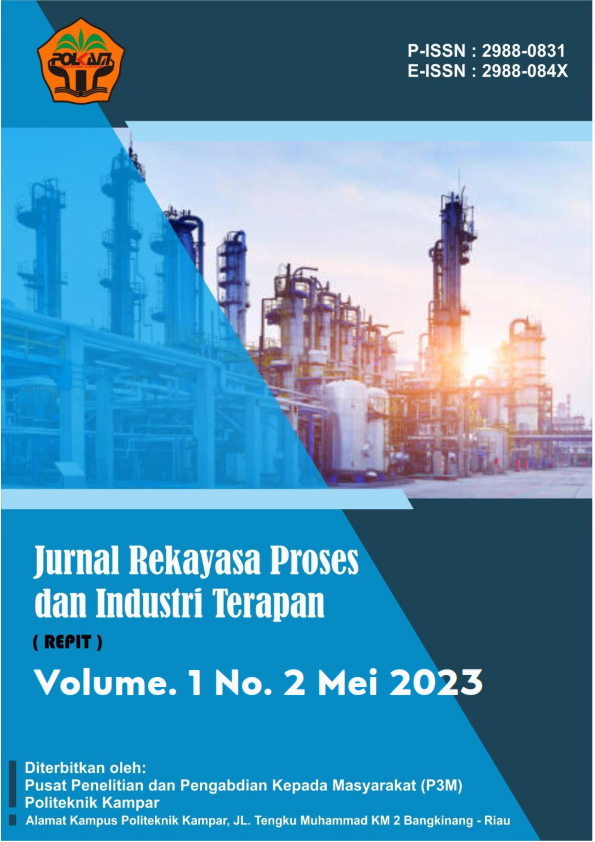Simulasi Hybrid Relay Protocol Pada Sistem Komunikasi Kooperatif Dengan Maximum Ratio Combining
DOI:
https://doi.org/10.59061/repit.v1i2.176Keywords:
Cooperative Communication System, Hybrid Relay Selection, Maximum Ratio CombiningAbstract
The cooperative communication system functions to eliminate the effect of fading on the wireless channel. In a cooperative communication system, there are a number of relay nodes assigned to help the source transmit information to the destination. Hybrid Relay Protocol (HRP) is a combination of cooperative communication system protocols, namely AF and DF where the relay will choose one of the protocols using hybrid relay selection (HRS). Selection of the type of relay protocol used is based on the largest SNR. In this study, a performance simulation of the HRS cooperative communication system was carried out using the AF and DF relay protocol using the Maximum Ratio Combining (MRCC) technique. The parameter taken as a performance reference is the bit error rate (BER). Based on the simulation results when the SNR is 7 dB, the BER value for the DF protocol is 0, while for the AF protocol the BER value when the SNR is the same is 0.0355. Whereas the BER for the MRC technique at the destantion node has obtained a value of 0 when the SNR is 8 dB for the SC technique the BER value when with the same SNR is 0.0119.
References
K. J. R. Liu, A. K. Sadek, W. Su, and A. Kwasinski, Cooperative Communications and Networking, vol. 53, no. 9. 2008.
A. S. Ibrahim, A. K. Sadek, W. Su, and K. J. R. Liu, “Cooperative Communications with relay Selection: When to Cooperate and Whom to Cooperate With??,” IEEE Transcations Wireless Communication., vol. 7, no. 7, pp. 2814–2827, 2008.
T. Liu, L. Song, Y. Li, Q. Huo, and B. Jiao, “Performance Analysis of Hybrid Relay Selection in Cooperative Wireless Systems,” IEEE Transactions On Communication., vol. 60, no. 3, pp. 779–788, 2011.
T. Q. Duong and H. J. Zepernick, “On the performance gain of hybrid decode-amplify-forward cooperative communications,” Eurasip Journal Wireless On Communication Network., vol. 2009, 2009.
F. A. Onat, A. Adinoyi, Y. Fan, H. Yanikomeroglu, J. S. Thompson, and I. D. Marsland, “Threshold selection for SNR-based selective digital relaying in cooperative wireless networks,” IEEE Transaction Wireless Communication., vol. 7, no. 11, pp. 4226–4237, 2008.
X. Song, M. Zhang, W. Liu, and F. Liu, “Threshold-based hybrid relay selection scheme,” Proceedings of the World Congress on Intelligent Control and Automation (WCICA., vol. 2016–Septe, pp. 222–227, 2016.
Nosratinia, T. E. Hunter, and a Hedayat, “Cooperative communication in wireless networks,” Communications Magazine IEEE, vol. 42, no. 10, pp. 74–80, 2004.
Rappaport, T.S., “Wireless Communications: Principles and Practice 2/E”, Prentice Hall, 2001.
C. . J. K. W Peter Hong, Wan Jen Huang, Cooperative Communications and Networking. New York Dordrecht Heidelberg London, 2010.
Proakis, John G., Masoud Salehi., “Digital Communications”, The McGraw-Hill Companies, Inc., USA, 2008.
Khair. U, Suwadi, and Wirawan, “Performance of hybrid relay selection in cooperative communications system,” 2017 2nd International conferences on ICITISEE., 2017.

















